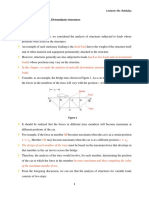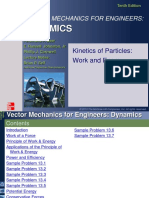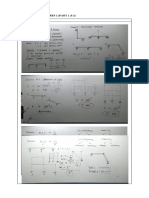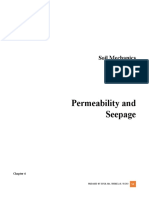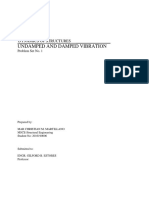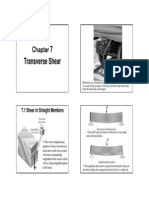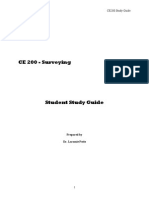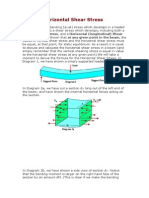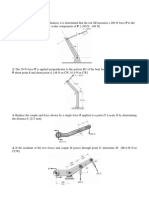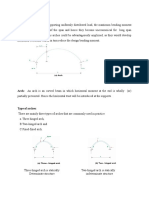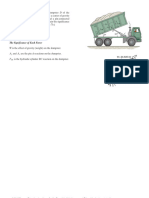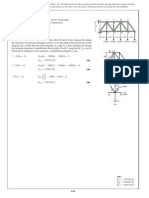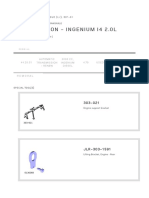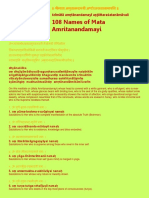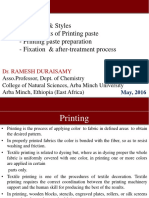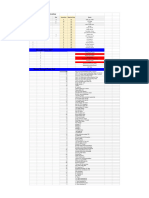2021
Submission on: 09-12-2021
ENGINEERING MECHANICS
ASSIGNMENT
RISHAV GOGOI
D/20/EE/101
B.Tech 2nd Year
1
�6.16. Determine the horizontal and vertical components of force which the pin at C exerts on member BC
of the frame.
SOLUTION I
Free-Body Diagrams. By inspection it can be seen that AB is a two
force member. The free-body diagrams are shown.
Equations of Equilibrium. The three unknowns can be determined by
applying the three equations of equilibrium to member BC.
∑MC = 0; 2000 N(2 m) - (FAB sin 60-)(4 m) = 0 FAB = 1154.7 N
∑Fx = 0; 1154.7 cos 60- N - Cx = 0 Cx = 577 N
∑Fy = 0; 1154.7 sin 60- N - 2000 N + Cy = 0
Cy = 1000 N
SOLUTION II
Free-Body Diagrams. If one does not recognize that AB is a twoforce
member, then more work is involved in solving this problem.
Equations of Equilibrium. The six unknowns are determined by
applying the three equations of equilibrium to each member.
Member AB
∑MA = 0; Bx(3 sin 60- m) - By(3 cos 60- m) = 0 (1)
∑Fx = 0; Ax - Bx = 0 (2)
∑Fy = 0; Ay - By = 0 (3)
Member BC
∑MC = 0; 2000 N(2 m) - By(4 m) = 0 (4)
∑Fx = 0; Bx - Cx = 0 (5)
∑Fy = 0; By - 2000 N + Cy = 0 (6)
The results for Cx and Cy can be determined by solving these
equations in the following sequence: 4, 1, 5, then 6. The results are
By = 1000 N
Bx = 577 N
Cx = 577 N
C∑= 1000 N
By comparison, Solution I is simpler since the requirement that FA be equal, opposite, and collinear at the
ends of member AB automatically satisfies Eqs. 1, 2, and 3 above.
2
�6.17. The compound beam shown in fig is pin connected at B. Determine the components of reaction at its
supports. Neglect its weight and thickness.
SOLUTION
Free-Body Diagrams. By inspection, if we consider a free-body diagram of the entire beam ABC, there will
be three unknown reactions at A and one at C. These four unknowns cannot all be obtained from the three
available equations of equilibrium, and so for the solution it will become necessary to dismember the
beam into its two segments, as shown in Fig.
Equations of Equilibrium. The six unknowns are determined as follows
Segment BC
∑Fx = 0; Bx = 0
∑MB = 0; -8 kN(1 m) + Cy(2 m) = 0
∑Fy = 0; By - 8 kN + Cy = 0
Segment AB
∑Fx = 0; Ax - (10 kN)13 5 2 + Bx = 0
∑MA = 0; MA - (10 kN)14 5 2(2 m) - By(4 m) = 0
∑Fy = 0; Ay - (10 kN)14 5 2 - By = 0
Solving each of these equations successively, using previously calculated results, we obtain
Ax = 6 kN Ay = 12 kN MA = 32 kN . m
Bx = 0 By = 4 kN Cy = 4 kN
3
�6.18. The two planks in Fig are connected together by cable BC and a smooth spacer DE. Determine the
reactions at the smooth supports A and F, and also find the force developed in the cable and spacer
SOLUTION
Free-Body Diagrams. The free-body diagram of each plank is shown in Fig. It is important to apply
Newton’s third law to the interaction forces FBC and FDE as shown.
Equations of Equilibrium.
For plank AD,
∑MA = 0; FDE(6 ft) - FBC(4 ft) - 100 lb (2 ft) = 0
For plank CF
∑MF = 0; FDE(4 ft) - FBC(6 ft) + 200 lb (2 ft) = 0
Solving simultaneously,
FDE = 140 lb FBC = 160 lb
Using these results, for plank AD,
∑Fy = 0; NA + 140 lb - 160 lb - 100 lb = 0
NA = 120 lb
And for plank CF,
∑Fy = 0; NF + 160 lb - 140 lb - 200 lb = 0
NF = 180 lb
4
�5
�6.19. The 75-kg man in Fig(a). attempts to lift the 40-kg uniform
beam off the roller support at B. Determine the tension developed
in the cable attached to B and the normal reaction of the man on
the beam when this is about to occur.
SOLUTION
Free-Body Diagrams. The tensile force in the cable will be denoted
as T1. The free-body diagrams of the pulley E, the man, and the
beam are shown in Fig. Since the man must lift the beam
off the roller B then NB = 0. When drawing each of these diagrams,
it is very important to apply Newton’s third law.
Equations of Equilibrium. Using the free-body diagram of pulley E,
∑Fy = 0; 2T1 - T2 = 0 or T2 = 2T1 (1)
Referring to the free-body diagram of the man using this result,
∑ Fy = 0 Nm + 2T1 - 75(9.81) N = 0 (2)
Summing moments about point A on the beam,
∑MA = 0; T1(3 m) - Nm(0.8 m) - [40(9.81) N] (1.5 m) = 0 (3)
Solving Eqs. 2 and 3 simultaneously for T1 and Nm, then using Eq. (1)
for T2, we obtain
T1 = 256 N Nm = 224 N T2 = 512 N
SOLUTION II
A direct solution for T1 can be obtained by considering the beam,
the man, and pulley E as a single system. The free-body diagram
is shown in Fig. Thus,
∑MA = 0; 2T1(0.8 m) - [75(9.81) N](0.8 m)
- [40(9.81) N](1.5 m) + T1(3 m) = 0
T1 = 256 N
With this result Eqs. 1 and 2 can then be used to find Nm and T2.
6
�6.20. The smooth disk shown in Fig. (a) is pinned at D and has a weight of 20 lb. Neglecting the weights of
the other members, determine the horizontal and vertical components of reaction at pins B and D.
SOLUTION
Free-Body Diagrams. The free-body diagrams of the entire frame and
each of its members are shown in Fig. b. Equations of Equilibrium. The
eight unknowns can of course be obtained by applying the eight
equilibrium quations to each member—three to member AB, three to
member BCD, and two to the disk. (Moment equilibrium is
automatically satisfied for the disk.) If this is done, however, all the
results can be obtained only from a simultaneous solution of some of
the equations. (Try it and find out.) To avoid this situation, it is best
first to determine the three support reactions on the entire frame;
then, using these results, the remaining five equilibrium equations can
be applied to two other parts in order to solve successively for the
other unknowns.
Entire Frame
∑MA = 0; -20 lb (3 ft) + Cx(3.5 ft) = 0 Cx = 17.1 lb
∑Fx = 0; Ax - 17.1 lb = 0 Ax = 17.1 lb
∑Fy = 0; Ay - 20 lb = 0 Ay = 20 lb
Member AB
∑Fx = 0; 17.1 lb - Bx = 0 Bx = 17.1 lb
∑MB =0; -20 lb (6 ft) + ND(3 ft) = 0 ND = 40 lb
∑Fy = 0; 20 lb - 40 lb + By = 0 By = 20 lb
Disk
∑Fx = 0; Dx = 0
∑Fy = 0; 40 lb - 20 lb - Dy = 0 Dy = 20 lb
7
�6.21. The frame in Fig. a supports the 50-kg cylinder. Determine the horizontal and vertical components of
reaction at A and the force at C.
SOLUTION
Free-Body Diagrams. The free-body diagram of pulley D, along with the cylinder and a portion of the cord
(a system), is shown in Fig. b. Member BC is a two-force member as indicated by its freebody diagram. The
free-body diagram of member ABD is also shown.
Equations of Equilibrium. We will begin by analyzing the equilibrium of the pulley. The moment equation
of equilibrium is automatically satisfied with T = 50(9.81) N, and so
∑Fx = 0; Dx - 50(9.81) N = 0 Dx = 490.5 N
∑Fy = 0; Dy - 50(9.81) N = 0 Dy = 490.5 N
Using these results, FBC can be determined by summing moments about point A on member ABD.
∑MA = 0; FBC (0.6 m) + 490.5 N(0.9 m) - 490.5 N(1.20 m) = 0
FBC = 245.25 N
Now Ax and Ay can be determined by summing forces.
∑Fx = 0; Ax - 245.25 N - 490.5 N = 0 Ax = 736 N
∑Fy = 0; Ay - 490.5 N = 0 Ay = 490.5 N
8
�6.22. Determine the force the pins at A and B exert on the two-member frame shown in Fig. a.
SOLUTION I
Free-Body Diagrams. By inspection AB and BC are two-force
members. Their free-body diagrams, along with that of the pulley,
are shown in Fig.b. In order to solve this problem we must also
include the free-body diagram of the pin at B because this pin
connects all three members together, Fig. c.
Equations of Equilibrium: Apply the equations of force equilibrium
to pin B.
Fx = 0; FBA - 800 N = 0; FBA = 800 N Ans.
Fy = 0; FBC - 800 N = 0; FBC = 800 N Ans.
Note: The free-body diagram of the pin at A, Fig.d, indicates how
the force FAB is balanced by the force (FAB>2) exerted on the pin by
each of the two pin leaves.
SOLUTION II.
Free-Body Diagram. If we realize that AB and BC are two-force
members, then the free-body diagram of the entire frame produces
an easier solution, Fig. e. The force equations of equilibrium are the
same as those above. Note that moment equilibrium will be
satisfied, regardless of the radius of the pulley.
9
�F6–13. Determine the force P needed to hold the 60-lb weight in equilibrium.
Step 1
We are given the following data:
The magnitude of the attached weight is W=60lb
.We are asked to determine force P needed to hold the attached weight in the equilibrium condition.
Step 2
We will draw a free body diagram of the truss. The tension in the cable is same throughout the length.
Step 3
We will equate the sum of the forces in the y direction equal to zero to determine the force P
∑Fy=0
3P−W=0
Substitute all the known values in the above formula.
3P−(60lb)=0
3P=(60lb)
P=(60lb)/3
P=20lb
10
�F6-14. Determine the horizontal and vertical components of reaction at pin C.
Solution
Step 1
By dismembering the frame and drawing the free-body diagram
of part BC we can notice that there are three unknown member,
so line of action of force RB goes through point A, i.c. force RB
makes with the horizontal angle of
α = tan-14/3
α = 53.130
Step 2
By equating sum of moments about point B to zero we can determine force C y
∑MB = 0
400.3 + 500.6 – 9 Cy=0
4200 - 9Cy=0
Cy= 4200/9
Cy= 466.67
Step 3
By equating sum of forces in y-direction to zero, we can determine the force R B
Fy = 0
RB sin53.130 – 400 – 500 + Cy = 0
RB sin53.130 – 900 + 466.67 = 0
RB sin53.130 – 433.33 = 0
RB = 433.33/sin53.130
RB = 541.66 lb
Step 4
Finally, by equating sum of force in x-direction to zero, we can determine the reaction force C x
∑Fx = 0
RB cos53.130 – Cx = 0
Cx = RBcos53.130
Cx = 541.66cos53.130
Cx = 325.00 lb
Therefore, Cx = 325.00 lb Cy = 466.67 lb
11
�F6–15. If a 100-N force is applied to the handles of the pliers, determine the clamping force exerted on the
smooth pipe B and the magnitude of the resultant force that one of the members exerts on pin A.
Step 1
We’ll dismember the item and draw the free-body diagram
of the front part with reaction force A and B, and 100-N force
acting at it,
The reaction force at B is normal to the surface.
By equating sum of moments about point A to zero we can
determine reaction force at B.
MA = 0
100.250 – FB . 50 = 0
FB = 100.250/50
FB = 500 N
Step 2
By equating sum of forces in x- and y- direction to zero we can determine reaction force at point A
Fx = 0
Ax – FB cos 450 = 0
Ax = FB cos 450
Ax = 500 cos 450
Ax = 353.55 N
Fy = 0
100 + FB sin 450 – Ay = 0
Ay = 100 + FB sin 450
Ay = 100 + 500 sin 450
Ay = 453.55 N
Step 3
Magnitude of reaction force at point A is
A = √(Ax2 + Ay2)
A = √(353.552 + 453.552)
A = 575.07 N
12











